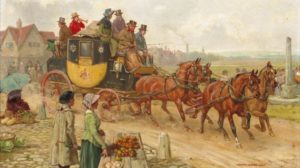
It shouldn’t be a surprise that passing the time while travelling in a vehicle was, in the Regency era the same as today, sometimes as simple as a game. Like slug bug or I-Spy, Travelling Piquet was a points game passengers played based on the things they saw out their carriage window.
From Grose’s (1811) Dictionary of the Vulgar Tongue:
Travelling Piquet: “A mode of amusement, practiced by two persons riding in a carriage, each reckoning towards his game the persons or animals that pass by on the side next them, according to the following estimation:”
A parson riding on a gray horse with blue furniture: game
An old woman under a hedge: game
A cat looking out of a window: 60 points
A man, woman, and a child in a buggy: 40 points
A flock of sheep: 20 points
A flock of geese: 10 points
A postchaise: 5 points
A horseman: 2 points
A man or woman walking: 1 point
I found this mention in an add in a 1837 guidebook to Bolgna:
I found the same ad in another 1837 guidebook to the Isle of Wight.
I wasn’t able to get a full copy of the book Light Come, Light Go (1909) but gleaned from the preview that travelling piquet was a carriage game developed by the sporting/betting mad men to pass the time in the carriage by betting on what they might see up ahead. It was then later adapted by Lady Caroline for the commercial market, perhaps after it had been Beta tested. I am suspicious of the claims of authorship from the ad, because it appeared in the 1811 Grose dictionary with no attribution, whereas that seems to have been the standard when relevant.










I love this. Thanks for sharing the information. I’m a bit confused as to how the points would be awarded based on what they saw. Do you have a sense as to how the points were allocated?
I loved it, too, so I am so glad you enjoyed! I found this article that talks about these sorts of travelling games (https://wellcomecollection.org/articles/Xbw64RIAACIAQnf8) that might help a bit. My sense is its a bit like slug-bug, except you can only call out things you see from your side of the carriage, the other person confirms, and then you keep track of your score with the ultimate goal of getting to 100. So if you are riding on the left side, and I the right side, I can only really look out the right window and you the left. If I see a flock of sheep, I am assuming I would shout “a flock of sheep” and you would look to confirm, and I would add 20 points to my tally, whereas if you were to look out and spy an elderly woman under a hedge I would confirm and declare you the winner.
My guess is there were likely variations of the game, depending on where you were (countryside or Town).
I added a bit more to the post, after a deeper search to find more rules.
Thanks for explaining it. This blog post came at a perfect time since I’m writing a travel scene. It gave me something fun to include. I’ll be sharing the post on Twitter too, to spread the info.
I love it, Laurie, thanks for sharing! If you can remember to let us know when the book is published, I would love to share with readers.
Based on the point system it says a lot about what a traveler might encounter on the road. For example, a man or woman walking garnered only 1 point because it was common to see such. Next is a man on a horse (2 points) followed by a postchaise (5 points) and so on until you get to the impossible “a parson riding on a gray horse with blue furniture.”
I had the same thought! It does make you wonder about what sparked the specificity of the parson riding on a gray horse with blue furniture points, however, or the old woman under a hedge.
I get a laugh out of thinking how I might have designed the points system for my own amusement.